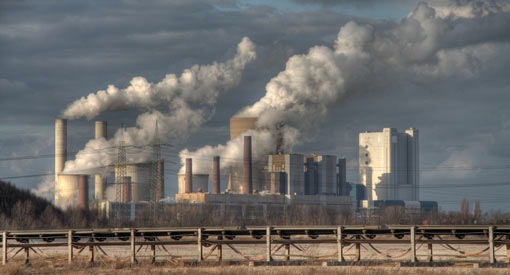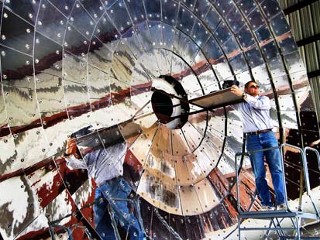Is Oxygen depletion more worrying than global warming?
There is serious doubt whether carbon dioxide emissions are a major driver for global warming or, as it has recently come to be called, 'climate change'. Water vapor is a more potent greenhouse gas and the sun's influence on our climate is orders of magnitude stronger than any amount of carbon dioxide we could ever produce. But carbon dioxide may have a secondary effect that has been hardly mentioned in the past. Every time a carbon dioxide molecule is produced by burning carbon-based fuels including oil and gas, two oxygen atoms get locked up together with one of carbon. The oxygen that drives the burning process comes from the atmosphere.
Until recently, I had been under the impression that oxygen levels in the atmosphere are quite stable around 21 per cent, and have been so for a long time. However in a recent discussion about burning coal as fuel, some interesting information emerged that tends to disprove the concept of a stable oxygen level.
Historical trends, as explained in Atmospheric Oxygen, Giant Paleozoic Insects and the Evolution of Aerial Locomotor Performance by R. Dudley, JExB, show a high of about 35% just before the beginning of the Permian, with a rapid decline to a low of about 13-14% near the beginning of the Triassic, then a small spike at about 17% in mid Triassic, another drop to about 14-15% early in the Jurassic, a sudden climb to about 21% by mid-Jurassic, then a gentle climb to about 26% early in the Tertiary, and a rather constant, steady decline to the present "20.9%."
But even now, we are not necessarily assured of a more-than-20-per cent oxygen level in the air at all times.

Coal fired power plant - Image credit: Sun-volt.com
In that discussion, Adrian said: "There is really no such thing as "clean" coal. Even if you take all of the non-carbon contents out, the resultant burning still produces enormous amounts of carbon dioxide. We may be getting to the stage where we will have to be concerned about the amount of oxygen we have left in the atmosphere to breathe... I read that a research paper comparing the health of people living at low compared to high altitudes showed that it was the lack of oxygen that was harmful for certain ailments.Oxygen used to be about 20% of the atmosphere but today in some places, it is as low as 16%. Carbon dioxide is actually a fairly heavy gas (molecular weight 44 as compared to oxygen 32 and nitrogen 28) so that during times of little wind, it would have a tendency to settle in pockets. That is one reason cave exploration can be so hazardous.
People living in large cities in India have such a high incidence of lung disease that older diesel motors have been banned. I have not read any carbon dioxide studies but reducing the amount of oxygen available, certainly places a strain on the heart, especially for old people with weak hearts and those with any type of lung problems.
Carbon dioxide sequestering seems to be a stupid idea because the process also sequesters oxygen in the process. Someone needs to present calculations showing how the burning of coal, oil and natural gas is affecting our oxygen supply. The question really boils down to "how much oxygen would be left in the atmosphere if all fossil fuels were consumed?" Yes, people will say that trees and algae will take care of the oxygen production but the real concern is what level of oxygen is required to maintain a good healthy atmosphere for humans as well as for other living organisms."
So it appears the oxygen content of air is not uniform all over the planet, some places seem to be much worse than others. The cause: use of carbon-based fuels, together with our disregard for the contribution of forests to keeping the air breathable.
- - -
Robert supplied a link to a website about depleting oxygen levels.
http://www.trufax.org/general/oxygen.htmlHe added: Another 2% down and we suffocate...
CO2 can be sequestered in the coal plant. I question whether it captures oxygen too. It would be nice if some brainiac could figure a profitable way to split CO2 into C + O2.
Since carbon dioxide is one carbon atom and two of oxygen, sequestering CO2 to "put it into storage", as proposed by some who would like to see us continue using carbon based fuels will indeed sequester the oxygen together with the carbon. The more CO2 we produce, the more of the free oxygen in the atmosphere we deplete.
Photosynthesis of green plants reverses the trend, but as we are cutting down forests to make room for grazing animals or to grow crops of industrial raw material or biofuels, we have less and less help from the plants. There is even a possible technologal fix that could reverse the trend, but it's not been developed into a usable technology. Sandia Laboratory's Nathan Siegel is one of the scientists working on a project to turn carbon dioxide into carbon monoxide, releasing one of CO2's bound oxygen atoms by harnessing solar energy. (Turning Carbon Dioxide into Fuel)

Giant solar collector at Sandia National Laboratories to power a novel reactor capable of producing carbon monoxide from carbon dioxide - Image: Randy Montoya at ABCNews.
"Carbon dioxide is a combustion product, so what we're doing is reversing combustion," Siegel says. The carbon monoxide can then readily be employed to produce a range of different fuels, including hydrogen, methanol, and gasoline, using conventional technologies.
Returning to the discussion that started this, Adrian added another thought: "I was certain that the increased burning of carbon fuels with the accompanying destruction of forest has had an adverse impact on the oxygen in our atmosphere and the above web site (http://www.trufax.org/general/oxygen.html) confirms my thinking in a most frightening manner. I do not think most people realize the dilemma which seems to boil down to the choice between breathable air or continued and increased burning of fuels. Right now we are stuck with the problem of Global Warming and no one seems to realize that our oxygen supply is becoming much more at risk as time goes by. I know that game fish cannot exist in lakes that have been depleted of oxygen because of excess algae growth stimulated with the dumping of phosphates and similar chemicals but now we are entering a like situation with our own atmosphere.I think the answer is awareness of the problem and the realization that we must turn to other sources of energy. I also believe that the problem of oxygen depletion needs to be brought to the attention of all in order to solve this seemingly innocuous but in truth, serious problem.
And another participant brings his own views on oxygen levels. Paul weighs in saying:
"This issue of oxygen depletion is one which is more of a local phenomenon. In Alabama where I live the O2 levels fluctuate between about 22% and about 19% on a varied daily and monthly cycle with the photosynthesis of the forest here. In Mexico City this level has dropped to about 17% max and minimum 14% with thousands who die each year from the problem and this has been some years now. Mexico City has lost between 5000 and 15000 persons a year this way for a decade or more. They just die quietly in the night and are scooped up in a day or two and disposed of without comment.In Europe it of course varies with location but the big cities of Europe typically never see above 19%. Many Asian cities frequently see as low as 15% or 14%. (China/India) Oxygen bars were invented because of this in Asia.
The essential problem with CO2 is that the solution [we need] is Photosynthesis. It works and it doesn't soak up energy... It collects it.
This really is the issue with more fuel. You can forget Global Warming. It is dead. The Sun just put that to rest. Nothing Mankind can do if the current trend continues will avoid an ICE Age shortly. It may be a minimal one but we are getting colder."
Although the advocates of global warming continue to say that temperature is increasing, in the last ten years that has not been the case. We also have an extreme low of solar activity with little or no sun spots showing this year.
What we need is to get global warming/climate change out of the political arena. Too many interests are bad for scientific inquiry and debate.
And for sure we should look at the possibility that our production of CO2, even though it may not bring about global warming, could be the driving force for a different and possibly much worse problem: death by insufficient oxygen, in other words, slow suffocation.
See also:
Man-made Global Warming - The Debate is not over!
Water Vapor Rules the Greenhouse System
Astrophysicist Links Temperature Change with Sun's Energy Output





whip out Lao&Walter Russell's book "Atomic Suicide" - where they warn us, in 1958, that if we do not stop using atomic power, it will accumulate in the topmost parts of the atmosphere, and eat up the ozone + oxygen.
Why do we look at everything from the human point of view? In the worst case of your scenario, a large percentage of life on this planet vanish, would the Earth, freed from the yolk of the human burden, regenerate and regain its pristine state? History says so. So whats the flap about? Extinctions are natural and we may next in line.
Anyway. if we manage to fix every single existing problem, we would live for ever?
I do not understand Scientists. They are so arrogant.
You have a point, Prem ... what makes us so precious?
Still - I think it is natural that we look at things from our viewpoint with a desire to ensure survival of self and the species.
My purpose in pointing to the issue of depletion of oxygen is not so much to "save us" as it is to look at what we are doing to the planet from different angles. After all, if we do want to survive, we better amend our ways.
1. CaCO3 Sequestration and O2-consuming Fuels as strategically Probably Dead Ends (don't count out technological cat's-cradle creativity, but don't count *on* it either); and
2. Cancer triggered by Anoxia --biomolecular, in vitro and clinical epidemiological considerations linked to atmospheric degradation contribution to environmental stress
1. It appears that disposing of CO2 via sequestration as CaCO3 may not be a strategically sustainable path per se because each CO2 requires an additional oxygen molecule either from the atmosphere -- resulting in 50% faster oxygen depletion -- or from somewhere else at an energy cost.
However the production of fuels from carbon monoxide, described below, still reduces net atmospheric O2, while increasing net atmospheric CO2; it's no solution in itself to the risk of suffocation.
Both of these approaches would for true life-cycle sustainability presuppose an energy throughput configuration which requires an additional energy input to sustain the recycling of fossil, i.e., non-atmospheric, carbon without a corresponding net consumption of precious atmospheric oxygen and production of carbon dioxide.
I think this is not necessarily a zero-sum or entropic mug's-game -- use-value could justify resource allocation and heat losses -- but we should be exceedingly careful to exercise open eyes. Caveat Emptor ["Buyer beware"].
2. Also, what about the demographic impact on the incidence in organisms of cancers triggered under changing threshold conditions by cellular reversion to anaerobic metabolism due to diminished environmental oxygen? See the work of Otto Warburg, and Vitamin C discoverer Albert Szent-Gyoergyi;s 1976 book Electronic Biology and Cancer (Marcel Dekker, New York). This may be contributing to our current cancer epidemic. is any reader aware of predictive modelling, perhaps tested by comparison with in vitro cell cultures and urban or occupationally-linked cancer epidemiologies?
Ernst von Bezold
Here is an interesting article in connection with this problem. A company in New Zealand is developing a way of sequestering CO2 in charcoal, which subsequently gets used to improve agricultural soils.
New Zealand Company Locks Away CO2 in Charcoal
Pumping it back into the ground (like the US does,in N-Alaska with Natural Gas) is a waste of MORE energy.
Better to build a hothouse next to P-plants and grow algae for fuel and food for fish. Another is the "Orion Project"
I believe that your concerns about oxygen depletion are entirely misplaced.
Don't forget that oxygen makes up about 20% of the atmosphere while carbon dioxide makes up about 0.04%. Doubling the carbon dioxide content of the atmosphere will reduce the oxygen content to about 19.96%.
The significant problem is localized, not global, levels of oxygen.
Agreed that the problem is more local than global.
I wouldn't be so sure about the concerns being "entirely misplaced".
Philip says (by email):
OK Sep, I know you to be always unbiased and a searcher for truth. But we all risk being manipulated..
Re your story concerning oxygen, this is a worry, because if the sea gets more polluted, our O2 will go down.. As regards our use of fossil fuels, I think this is more than balanced by our controls.. We do not have every home and tribe burning wood.. also we control wild fires, which on a less inhabited primitive planet always would go unchecked, Lightning etc, then volcanic activity is always eating up 02 much faster than our Power stations. ...
So we must keep our seas clean, which provides 90% plus of our air..
As regards global warming, a known a falsie based on bad science, is now climate change, to accomodate the change to global cooling .. as the evidence of the last two years shows.. You got it right its the sun...
Now just one more important point.. Your picture of the Power station, typical of media touted pictures.. All of that "smoke" is steam, from the cooling towers, the fat large diameter towers, and the tall one is the ash extraction which also uses lots of water which ejects steam and some ash when things are not going right.
... the boiler chimneys are in the foreground, and rarely show any smoke except when something is wrong.. The CO2 is invisible. This picture is typical of media manipulation of propaganda on the masses..
Thank you for this comment, Philip,
you are right about the picture. most chimneys today are no longer belching smoke as they used to in the olden times, and much of the "smoke" in the picture I chose to accompany the article may indeed be vapor rather than smoke.
The major problem with our fossil fuel based technologies is really pollution. Lots of people with lung problems these days...
What about the role of phytoplankton in the natural processes that regulate carbon dioxide / oxygen levels.
Would not increased Co2 promote growth of pyytoplanton which being a plant would soak up the co2 and produce more oxygen.
I am of the belief that the balance between these processes are that factors that mantain the breathable atmosphere of the planet.
phytoplankton does bind CO2 I believe and in the process must release some of the oxygen so yes, plankton is one of the major sinks for CO2 in our planetary environment.
The trouble is, plankton is limited by mineral content in sea water - only so much plankton can grow each season or "bloom" as they call it.
There has been a proposal to seed the world's oceans with iron nanoparticles, that would provide some of the needed mineral content for the plankton, but I believe it's been shelved as too little is known on how eventually it might affect the environment or some delicate equilibrium that we know nothing about...
It reminds me of the disaster of modern agriculture, where selective fertilization with only three minerals is unbalancing the nutrient content in many farm products.
Would not the simplest answer be in planting trees by the millions?
It would address the problem on multiple fronts. Lock up carbon and generate more oxygen. Improve weather patterns, prevent floods etc.,etc.
Make arid and semi-arid regions of the world, generally devoid of human populations, more productive by blanketing them with genetically altered trees.
It would also address the desertification problem as an added bonus.
Maybe trees are all we need, unless, that is, an asteroid hits us and make all this academic.
Yes, apart from technical solutions (using renewable energy, getting off oil, coal and gas) planting trees would be ideal.
I do not agree that the trees should be genetically altered though. That technology is not well in hand (despite what we hear from its promoters). Genetic alteration is a hit-and-miss affair, and any number of traits can be changed, including ones that were not a target for change. Why not use what Nature already gave us and has tried out for millions of years?
With a bit of help from human planters, many arid and semi-arid zones could soon have green cover. It could be done as an 'official' program, but it might just as well be a popular initiative, where people everywhere do the planting. Just needs some direction and a campaign...
Atmospheric "Oxygen Depletion" is an Even More Disastrous Consequence than the "Global Green House Effect" to the Continuance Healthy Survival of Mankind
Chen I-wan (cheniwan@263.net)
Advisor, Committee of Disaster Historical Studies for China Disaster Prevention Association
(Original draft posted on Internet in Aug. 2005. Published by: a) The Proceedings of the "4th Environment and Development China (International) Forum", Beijing, Oct. 2008; b) The “China Population, Resources & Environment” journal 2008 Vol.18 special issue)
Abstract: Reveals the core issue of the comprehensive complex massive system problem of "energy & atmospheric pollution" today is still unrecognized by most members of the world science and technology community and all members of the world industry: Excessive burning of fossil fuel and "new fuels" not only causes disastrous consequence of "green house effect global warming", but at the same time also cause another disastrous consequence of atmospheric "oxygen depletion". Reviews the formation and changes of the oxygen and carbon dioxide contained in the Earth's atmosphere; and the dramatic fluctuation of atmospheric oxygen content during the Earth's history and serious effect on the biosphere; presents science evidence of continuance reduction of global atmospheric oxygen content; warns that "Hydrogen Energy, Hydrogen Economy" will more seriously cause atmospheric "oxygen depletion". Stress that most serious atmospheric "oxygen depletion" problem exists in major cities and advance developed economic regions! The "Atmospheric Environment Quality Standard" (National Standard GB3095-82) issued in 1982, the Environment Air Quality Standard (National Standard GB3095-1996) implemented in 1996, and the Environment Air Quality Monitoring Standard implemented in 2007, exists serious defects: It does not monitor carbon dioxide (CO2), and does not monitor atmospheric oxygen, must be revised as soon as possible!
Keywords: Fuel excessive burning, greenhouse effect, global warming, atmospheric "oxygen depletion", definition.
These discussions are sometimes not balanced. The world population is increasing at eighty three million people per year. Compare that to a maximum of a few hundred thousand dying from oxygen depletion. Oxygen depletion is not a global catastrophe. On a global scale it is trivial.
The phytoplancton in our oceans,which produce over 50% of our oxygen,are dying.over 40% are now dead. As the oceans continue to acidify, the total death rate will increase in pace. With the deforestation in Brazil,millions of haectares of land are being used as pasture, these lands create oxygen sinks , which take O2 from the atmosphere. coupled with the great forest die offs in russia and canada and with the continued changing of tropical lands around the equator to palm oil plantations, our source of oxygen has been cut by more than 60%, and declining. human beings need 19.7 ppm (Dr. Mae-Wan Ho) wer'e on our way to becoming exstinct. Which is the day of no return?